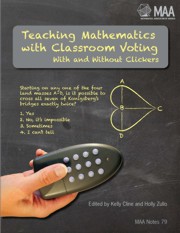Book contents
- Frontmatter
- Contents
- I An Introduction to Teaching Mathematics with Classroom Voting
- II Studies of Classroom Voting in Mathematics
- III Classroom Voting in Specific Mathematics Classes
- 6 Questions to Engage Students in Discussion (Q.E.D): Using Clickers in a Mathematics for Liberal Arts Course
- 7 Clickers in Introductory Statistics Courses
- 8 Using Clickers in a Statistics Classroom
- 9 Engaging Statistics Students with Classroom Response Systems
- 10 Incorporating Clicker Technology in the Introductory Statistics Course
- 11 Using Clickers in Courses for Future K–8 Teachers
- 12 Using Clickers in Professional DevelopmentWorkshops
- 13 Using ConcepTests in College Algebra
- 14 An Example of Multi-Purpose Use of Clickers in College Algebra
- 15 ConcepTests—Classroom Voting: A Catalyst for an Interactive College Algebra ClassroomD
- 16 Using Clickers to Encourage Communication and Self-Reflection in Precalculus
- 17 Writing and Adapting Classroom Voting Questions: New Functions from Old
- 18 Enhancing Student Participation and Attitudes in a Large-Lecture Calculus Course
- 19 Good Questions for Mathematics Eduction: An Example from Multivariable Calculus
- 20 Integrating Classroom Voting Into Your Lectures: Some Thoughts and Examples from a Differential Equations Course
- 21 Classroom Voting Questions that Provoke Teachable Moments in Differential Equations
- 22 Teaching Linear Algebra with Classroom Voting: A Class Period on Linear Independence
- 23 Lesson Planning with Classroom Voting: An Example from Linear Algebra
- 24 Using Clickers to Enhance Learning in Upper-Level Mathematics Courses
- Bibliography
- About the Editors
11 - Using Clickers in Courses for Future K–8 Teachers
from III - Classroom Voting in Specific Mathematics Classes
- Frontmatter
- Contents
- I An Introduction to Teaching Mathematics with Classroom Voting
- II Studies of Classroom Voting in Mathematics
- III Classroom Voting in Specific Mathematics Classes
- 6 Questions to Engage Students in Discussion (Q.E.D): Using Clickers in a Mathematics for Liberal Arts Course
- 7 Clickers in Introductory Statistics Courses
- 8 Using Clickers in a Statistics Classroom
- 9 Engaging Statistics Students with Classroom Response Systems
- 10 Incorporating Clicker Technology in the Introductory Statistics Course
- 11 Using Clickers in Courses for Future K–8 Teachers
- 12 Using Clickers in Professional DevelopmentWorkshops
- 13 Using ConcepTests in College Algebra
- 14 An Example of Multi-Purpose Use of Clickers in College Algebra
- 15 ConcepTests—Classroom Voting: A Catalyst for an Interactive College Algebra ClassroomD
- 16 Using Clickers to Encourage Communication and Self-Reflection in Precalculus
- 17 Writing and Adapting Classroom Voting Questions: New Functions from Old
- 18 Enhancing Student Participation and Attitudes in a Large-Lecture Calculus Course
- 19 Good Questions for Mathematics Eduction: An Example from Multivariable Calculus
- 20 Integrating Classroom Voting Into Your Lectures: Some Thoughts and Examples from a Differential Equations Course
- 21 Classroom Voting Questions that Provoke Teachable Moments in Differential Equations
- 22 Teaching Linear Algebra with Classroom Voting: A Class Period on Linear Independence
- 23 Lesson Planning with Classroom Voting: An Example from Linear Algebra
- 24 Using Clickers to Enhance Learning in Upper-Level Mathematics Courses
- Bibliography
- About the Editors
Summary
Introduction
It is often the case that beginning K–8 teachers emphasize basic skills and procedures in their classrooms, but rarely probe more deeply for understanding and connections. This is not surprising, considering that this is what they probably experienced in their pre-college courses. Future teachers who themselves were students in classrooms that emphasized skills and procedures often lack deeper understanding or have developed basic misconceptions that make it difficult for them to probe or to answer questions from their own students about concepts and processes. The MAA Committee on the Undergraduate Program in Mathematics' Curriculum Guide [54] and the National Council of Teachers of Mathematics' Principles and Standards [62] recommended goals and objectives include that students develop the skill of understanding, representation, connections, and reasoning. This means that the curriculum should be seen as related ideas and concepts that can be used to solve a variety of problems, not as a set of unrelated facts and algorithms to be memorized.
Faculty teaching math content courses for teachers have a short window of opportunity to provide future teachers with experience in a conceptually rich environment. Faculty in these courses should model not only higher levels of questioning, but encourage higher level thinking. Unfortunately, often students find it difficult to know what they do not know. That is, students are not even aware that they do not understand the concept to which they have just been exposed or what they think they understand is actually a misconception.
- Type
- Chapter
- Information
- Teaching Mathematics with Classroom VotingWith and Without Clickers, pp. 77 - 82Publisher: Mathematical Association of AmericaPrint publication year: 2011

